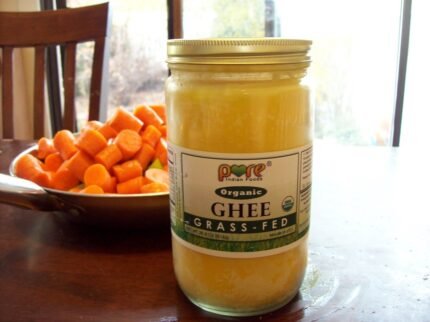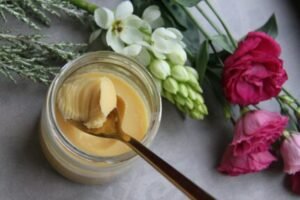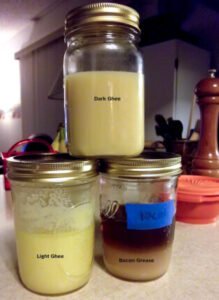Medically reviewed by Dr. Ramesh Gaddam, M.D. — Written by Sumalatha, D.N.H.E
Ghee is a type of clarified butter that is commonly used in Indian and South Asian cuisines. It is made by simmering butter to separate the water content and milk solids from the pure butterfat.
The process involves heating butter until it becomes liquid and then removing the impurities through straining, leaving behind a clear, golden-yellow liquid. Ghee has a rich, nutty flavor and a high smoke point, making it suitable for cooking at high temperatures.
Types of Ghee
There are different types of ghee available on the market, and the variations often depend on factors such as the source of the butter, the production methods, and any additional processing.

Here are some common types of ghee:
Cow’s Milk Ghee:
The traditional and most common type of ghee is made from cow’s milk. It is widely used in Indian and South Asian cuisines.
The quality and flavor of cow’s milk ghee can vary depending on factors such as the breed of cows, their diet, and the region where it’s produced.
Buffalo Milk Ghee:
Ghee can also be made from buffalo milk. Buffalo milk ghee tends to have a slightly different flavor and texture compared to cow’s milk ghee.
It is commonly used in certain regions, especially in parts of India.
Grass-Fed Ghee:
This type of ghee is made from the milk of cows that are primarily grass-fed.
Some people prefer grass-fed ghee due to the potential for higher levels of certain nutrients, including omega-3 fatty acids and vitamins.
Organic Ghee:
Organic ghee is produced using milk from cows that are raised according to organic farming practices.
This means that the cows are not treated with synthetic hormones or antibiotics, and the ghee itself is produced without the use of synthetic pesticides or chemicals.
Cultured Ghee:
In some variations, ghee is made from cultured butter, which is fermented before the clarification process.
This can add a tangy flavor to the ghee.
Homemade Ghee:
Many people choose to make ghee at home using unsalted butter.
This allows for control over the source of the butter and the production process.
Summary:
When selecting ghee, it’s important to consider factors such as the quality of the butter used, the production methods, and personal preferences for flavor.
Reading product labels and understanding the source of the ghee can help you choose a type that aligns with your dietary preferences and values.
Ghee Nutrition
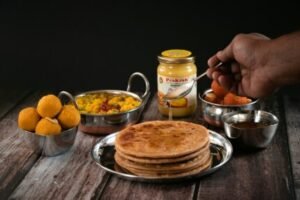
Nutrition facts of ghee per every one tablespoon (14g):
| Nutrient | Amount per 1 tablespoon (14g) |
|---|---|
| Calories | 112 |
| Total Fat | 12.7g |
| Saturated Fat | 7.9g |
| Monounsaturated Fat | 3.7g |
| Polyunsaturated Fat | 0.5g |
| Cholesterol | 33mg |
| Vitamin A | 489 IU |
| Vitamin E | 0.6mg |
| Vitamin K | 1.5mcg |
| Total Carbohydrates | 0g |
| Protein | 0g |
Ghee is often considered a beneficial ingredient for various reasons, and while individual responses may vary, here are some potential benefits associated with the consumption of ghee:
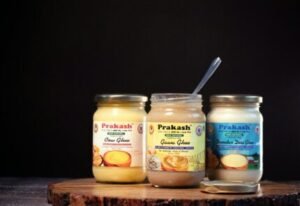
- Rich in Healthy Fats
- High Smoke Point
- Lactose-Free
- Rich in Fat-Soluble Vitamins
- Supports Digestion
- Anti-Inflammatory Properties
- Potential for Weight Management
Rich in Healthy Fats:
Ghee is a good source of healthy fats, including saturated fats, monounsaturated fats, and polyunsaturated fats.
It is particularly rich in short-chain and medium-chain fatty acids, which are believed to be easily digestible.
High Smoke Point:
Ghee has a high smoke point, which means it can be used for cooking at higher temperatures without breaking down into harmful byproducts. This makes it suitable for sautéing, frying, and other high-heat cooking methods.
Lactose-Free:
Ghee is essentially free of lactose and milk solids, making it a suitable option for individuals who are lactose intolerant or sensitive to dairy products.
Rich in Fat-Soluble Vitamins:
Ghee contains fat-soluble vitamins such as A, D, E, and K, which play crucial roles in various bodily functions, including immune health, bone health, and skin health.
Supports Digestion:
Some traditional medicine systems, such as Ayurveda, suggest that ghee can support digestion.
It is believed to stimulate the secretion of stomach acids, aiding in the digestion and absorption of nutrients.
Anti-Inflammatory Properties:
Ghee contains butyric acid, a type of short-chain fatty acid that may have anti-inflammatory properties.
However, more research is needed to fully understand the extent of its impact on inflammation.
Potential for Weight Management:
Some studies suggest that consuming moderate amounts of healthy fats, like those found in ghee, may help with satiety and weight management.
Medically reviewed by Dr. Ramesh Gaddam, M.D.

General Physician, Diabetologist, and Critical Care Specialist.
Discover more from Health Build-Up
Subscribe to get the latest posts sent to your email.
